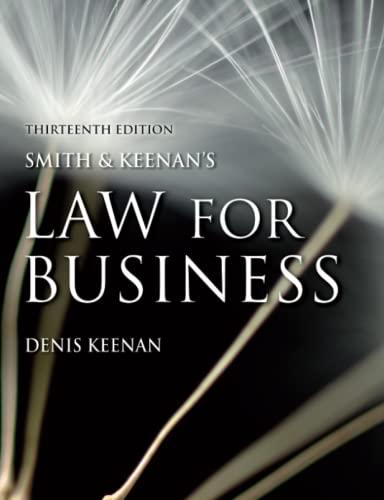Question
Eras Eras, the trendy Norwegian maker of cheap, do-it-yourself furniture that had recently become a hit in the U.S., had a problem. People loved their
Eras
Eras, the trendy Norwegian maker of cheap, do-it-yourself furniture that had recently become a hit in the U.S., had a problem. People loved their furniture but didn't love putting it together. The solution, executives thought, was to form an army of on-the-ready assemblers who would show up at customers' houses, efficiently put together the chair, desk, or bookshelf, and be on their way. Intrigued by recent advances in AI hiring methods, Eras contracted with a Silicon Valley firm to troll the internetespecially LinkedIn and Facebookfor people describing themselves as "handy."
An early hit was Bob Plain-Tiff, a recently retired architect who loved spending time in his garage-turned-woodshop. His Facebook feed was plastered with the delighted faces of friends, neighbors, and family members gifted with wooden creations from Bob's evolving catalogue, from bird feeders to deck furniture to decorative sculptures. Recently Bob's wife had encouraged him to branch out, and he had started offering woodworking services on Facebook Marketplace under the name "Bob's Wooden Creations." Since in return he only asked for a positive review of his handiwork on various online platforms (including a satisfied selfie), Bob became locally popular. A lawyer friend suggested that he incorporate and even trademark the budding brand, but Bob would agree only to set up a basic website with photos, contact information, and the insistence that customers "pay it forward" by doing good works for others. Amazingly, Bob received no money for his efforts, only the occasional fresh-baked apple pie or casserole.
While Bob was officially retired, a long-standing health issue had left his family with significant debt. For that reason, he was intrigued when Eras contacted him offering the "freedom and financial flexibility to do what you already love!"
Using the Eras app, Bob could log on at his leisure and be matched with an Eras customer hoping to outsource the tedious assembly of one of its thousands of compressed wood products. Bob's travel radius was limited to 10 miles, but the Big City was 8 miles to the east, so city traffic (and parking) was an unwelcome possibility. The app allowed him to reject 2 matches a week and he hoped to use those to cover any proposed jobs in the Big City.
There were also some rules to follow. While he had total control over his schedule, the amount of furniture to assemble was blacked out until the job was accepted.[1] As a result, an assignment might take 30 minutesor 5 hours. There was also a tee shirt he was required to purchase and wear and a mandatory greeting when a customer opened the door ("Never fear, Eras is here!").
Some things were somewhat open for negotiation. By default, Eras paid him with an hourly rate, but on the app the customer could check a box indicating that the customer was interested in negotiating for other "handyman" services while the assembler was on the premises. This might include hanging a picture, fixing a small leak, or even installing a ceiling fan. And while workers were generally expected to strictly follow Eras' instructions for putting furniture together (famously conveyed in an easy-to-understand picture format), Eras did allow for deviations with a customer's express permission. Thus, a worker could bring materials to try to sell a customer on a unique "upgrade," such as adding a special varnish on a bookshelf, an "easy-close" mechanism on a drawer, or an antique knob on an otherwise modern cabinet.
All transactions were required to be made through the app, and Eras took 20%.
Drawn in by the "upgrade" potentials, Bob decided to sign-up for Eras. The job was kind of fun initially, but most customersshopping at Eras for the cheap prices in the first placejust wanted their things assembled as quickly as possible. Once he tried to suggest an upgrade by pulling up a sample photo of a unique staining design from his website, but the customer complained and he received a text from Eras stating that he had received "Strike 1" (a third strike meant termination). Also, most of the jobs turned out to be in the Big City, and gas, parking, and car maintenance were taking a toll on his bottom line. Some weeks he calculated that his take home pay didn't even meet the state minimum wage.
Seeing the stress Bob was under, his wife urged him to quit and apply for unemployment benefits.
Question 1
Bob was denied unemployment benefits when Eras asserted to the unemployment agency that Bob was an independent contractor. Bob visits Huskie Furlife, a local employment lawyer, who asks you to analyze whether the independent contractor conclusion is correct. The state unemployment office determines employee status based on the following testrecently adopted by the state.
1. The degree of the alleged employer's right to control the manner in which the work is to be performed;
2. The alleged employee's opportunity for profit or loss depending upon managerial skill
3. The alleged employee's investment in equipment or materials required for the task, or the employment of helpers
4. Whether the service rendered required a special skill
5. The degree of permanence of the working relationship [and]
6. Whether the service rendered is an integral part of the alleged employer's business
Step by Step Solution
There are 3 Steps involved in it
Step: 1

Get Instant Access to Expert-Tailored Solutions
See step-by-step solutions with expert insights and AI powered tools for academic success
Step: 2

Step: 3

Ace Your Homework with AI
Get the answers you need in no time with our AI-driven, step-by-step assistance
Get Started


